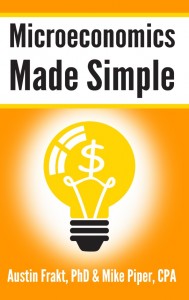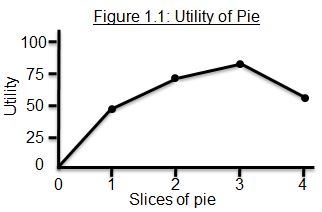The following is a lightly edited excerpt from Chapter 1 of Microeconomics Made Simple, by Austin Frakt and Mike Piper. You can find a summary of the book, its table of contents, and links to other excerpts here.
Maximizing Utility
In economics, the word “utility” refers to a person’s overall happiness or satisfaction. Economics assumes that each person’s goal when allocating his or her resources is to make decisions to maximize his or her utility (i.e., achieve maximum happiness).
What about Charity?
Some people think that trying to maximize utility is the same thing as acting selfishly. In reality, however, utility includes the happiness, sense of fulfillment, or anticipated spiritual rewards that come from charitable acts. In other words, giving your time or money to a cause you believe in may in fact be the best way to maximize your utility. (And an economist would say that, given the opportunity to choose freely, you would only take such charitable actions if you believed that they would maximize your utility.)
The Law of Diminishing Marginal Utility
“Marginal utility” refers to how much additional utility is derived from consumption of one additional unit of a particular good. In theory, with each dollar in her budget, a rational person would buy the good that provides the highest marginal utility for that dollar (i.e., the most additional happiness per dollar).
The reason people do not spend all of their money on a single good is that consumption of most goods follows the law of diminishing marginal utility. “Diminishing marginal utility” is less complicated than it sounds. Think about how you feel when you take your first bite of your favorite pie: It makes you happy, offering you very high utility. What about after you’ve finished a slice and you’re digging into your second? It doesn’t make you quite as happy because you’re fuller and the flavor is familiar. That is, the utility from the second slice is lower than the utility from the first. (It has “diminished.”) And it’s lower still for a third slice. Each additional slice of pie provides less happiness (utility) than the previous slice. And, at some point, another slice of pie would actually bring negative utility (perhaps from a stomach ache). That is, you would actually be happier as a result of not eating that slice of pie.
Figure 1.1 illustrates the law of diminishing marginal utility for pie. The figure assumes that you enjoy each of the first three slices of pie you eat (and it is the fourth that reduces your total utility). But, even though you enjoy the second slice, it doesn’t add as much to your utility as the first one did. The third adds even less. After the third slice, utility declines. (In Figure 1.1, the vertical axes is measured in something economists call “utils”—a hypothetical unit of utility.)
The above is a lightly edited excerpt from Microeconomics Made Simple (Copyright © 2014 Simple Subjects, LLC.) You can buy the book at Amazon.com.



